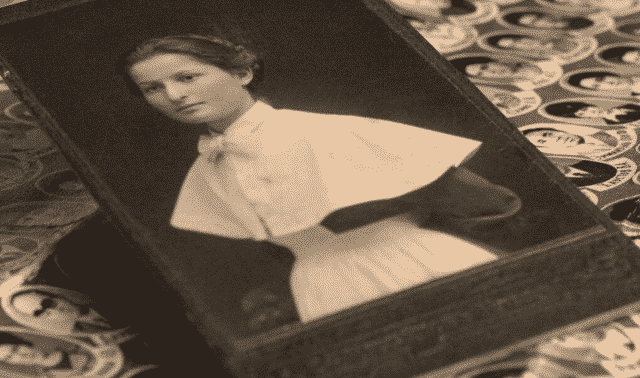Steven Barcomb often drove by the house his wife’s family had owned for about 50 years. One day, he noticed that someone was cleaning out the house and had discarded a large box of unlabeled 19th-century photographs. Thinking they were probably abandoned family pictures, he rescued them from the trash. Now, he has to figure out whom these photos depict.
The image pictured here is one of his favorites. He thinks it depicts his wife’s great-grandparents David Worden (1826-1915) and Lucretia Hogaboom Worden (1823-1916). Since the young woman’s dress, with its full bodice, dates to about 1900, it’s possible that he’s correct. The young woman in the portrait bears a striking resemblance to the older woman, and is probably her daughter. If that’s true, then the younger man could be her husband and the child their daughter. It’s a charming portrait of three generations of family. The grandfather’s playing a violin tells us that his music was important enough to feature in a family portrait. All of this could have been lost if Barcomb hadn’t picked up the box of photographs.
Unfortunately, his experience is not unusual. Everyday family photographs are often thrown out or sold. Make sure that never happens to your precious pictures by taking these steps:
1. Identify your pictures.
Start by using appropriate writing implements. A soft lead, such as a graphite sketching pencil, is best for labeling paper photographs. Contemporary paper prints, however, are on resin-coated paper that makes them difficult to write on unless you use a special pen. Look for ink that’s waterproof, fade resistant, permanent, odorless (when dry) and quick drying. Choose black ink because colored inks tend to fade over time. You can find photo-safe pens and pencils in most art-supply and scrapbook stores.
On the back of the image, write the full name and life dates of each person pictured. Even if you know only a surname, write it on the back of the photo. To learn more about labeling pictures, read my Photo Detective column in the October 2003 Family Tree Magazine.
2. Collect your family’s “unwanted” photos.
Growing up, I heard all about a distant cousin who asked lots of questions about family. I’ll admit that my parents counseled me about visiting this “odd” relative. When I finally met him, it turned out he was the self-appointed family historian. His questions were attempts to track down material. If it weren’t for him, lots of genealogical data would have been lost. Unfortunately, he didn’t collect the photographs. Still, you can learn from his methods and broadcast your desire to receive “unwanted” family pictures. This might require repeated attempts, but eventually you’ll succeed. You might even have to tactfully contact relatives after the loss of a family member to remind them that you want the pictures and documents. All this effort will be worth it. A couple of my friends have been doing this for years, and now own pictures of many of the branches on their family tree.
Don’t wait for a chance encounter. Steven Barcomb had no idea those pictures were in that house. Even though he hasn’t solved the picture mysteries in that box yet, this one identification will bring him closer. An unidentified photograph doesn’t have to remain that way forever if you follow the clues present in the image. But first you have to save them.



